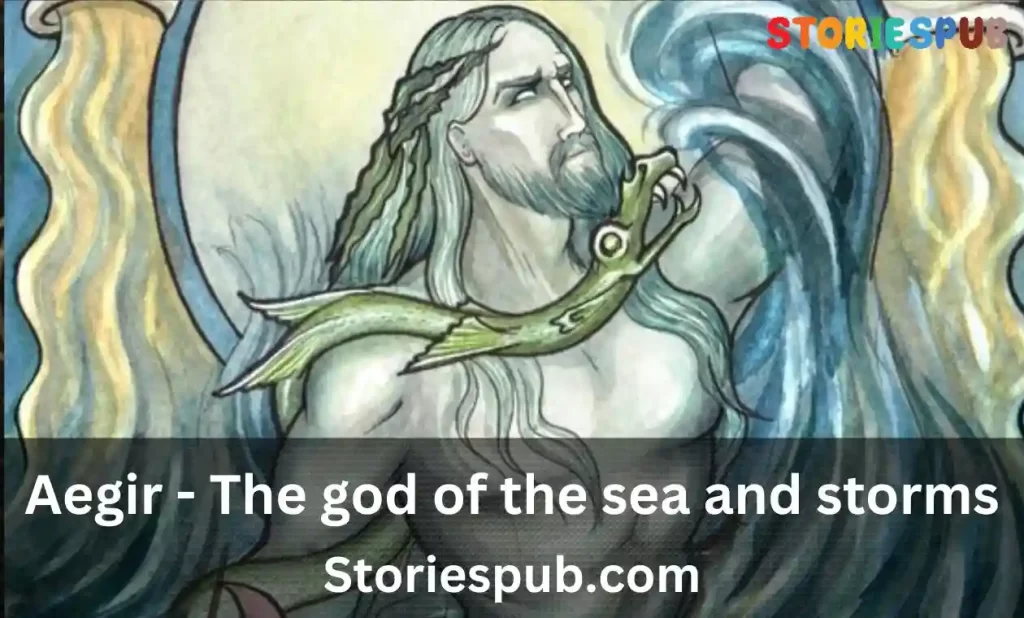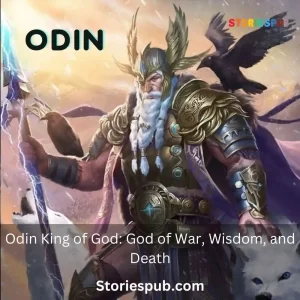Aegir – The god of the sea and storms

Introduction
Norse mythology is an intricate and rich tapestry of myths, gods, and legends that has captured the imagination of people for centuries. These stories are famous for their vivid characters, epic battles, and incredible feats of strength.
Among the many deities featured in Norse mythology is Aegir, the god of the sea and storms. Aegir is a figure that holds significant importance in Norse mythology due to his domain over one of nature’s most powerful forces: the sea.
He is both revered and feared by sailors who depend on him to guide them through treacherous waters safely. In this article, we will explore Aegir’s origins, his role in Norse mythology, his depictions in art and literature, as well as worship rituals dedicated to him.
Brief Overview of Norse Mythology
Norse mythology refers to a collection of myths from Scandinavia that were passed down orally before being recorded in written form. These stories are characterized by their divine beings with unique powers who interacted with humans through magical weapons or other supernatural means. The main pantheon of gods included Odin (the Allfather), Thor (the God of Thunder), Loki (the Trickster), Freya (the Goddess of Love), Heimdall (the Guardian), and many others.
Each deity had their own unique traits that set them apart from one another. Norse mythology also features creatures such as Giants, Elves, Dwarves which played important roles in various stories.
Introduction to Aegir: The God Of The Sea And Storms
Aegir’s name comes from Old Norse word ‘ægir’ meaning ‘sea’. He is often depicted as a giant with long hair made up entirely of seaweed or kelp.
His eyes are described as glowing red, and his voice is said to sound like the roar of the ocean itself. Aegir is believed to reside at the bottom of the ocean in a great hall called “Hlér’s Hall.”
Aegir has control over all aspects of the sea, including waves, tides, and storms. He is also known for his ability to produce ale, which he would serve to other gods during their feasts.
In Norse mythology, Aegir is married to Ran who helps him capture sailors lost at sea with her net. The power that Aegir possessed over such a vast element as the sea made him an important deity in Norse mythology.
People would often make offerings or prayers to Aegir before setting sail on voyages across treacherous waters. Aegir is an essential figure in Norse mythology.
His powers over the sea and storms reflect human’s dependence on nature while also highlighting its wildness and unpredictability. Throughout this article we will delve further into Aegir’s origins, role in Norse mythology, depictions in art and literature, worship rituals dedicated to him thereby gaining a better understanding of this powerful god.
Origins of Aegir
Family Background and Lineage
Aegir is a complex figure in Norse mythology, with his origins stemming from both primordial and divine sources. In terms of his familial background, he is the son of Fornjót, a giant who represented the power of winter and ice. Aegir’s mother is unknown, though some interpretations suggest that his father’s name was also used as an epithet for the ocean itself.
This would make Aegir not only the offspring of a giant but also an embodiment of the sea. As a result of his mixed heritage, Aegir did not fit neatly into either the realm of gods or giants.
He straddled both worlds, serving as a mediator between them and creating alliances by marrying into godly families. This made him an important figure in Norse mythology because it allowed for interaction between these two opposing forces.
Creation Story of Aegir
The creation story of Aegir is mired in mystery and debate due to inconsistencies in various texts which refer to him. However, one popular tale describes him as being born alongside his brothers Kari (the god of winds) and Logi (the god of fire).
They were said to have risen up from the depths during a great upheaval that rocked the world. According to this myth, when Odin created Midgard (the realm inhabited by humans), he tasked these three siblings with controlling its natural elements: wind, fire, and water respectively.
As such, Aegir was given dominion over all bodies of water including oceans and rivers. Another tale suggests that he was created alongside Ran – his wife – by an unknown deity as part of a larger pantheon.
Powers and Abilities
As one might expect based on their domains over wind/fire/water, Aegir has a number of impressive powers and abilities. For instance, he is said to have control over the tides and waves of the ocean, which he can manipulate to his advantage. Additionally, he has been known to use his power over water to summon sea creatures (such as whales or seals) in order to aid him.
Furthermore, Aegir possesses immense strength and durability due to his giant heritage. He is able to withstand powerful storms that would tear apart lesser beings, and can swim for days on end without tiring.
One of his most interesting abilities is that he can brew ale that never runs out – an important ability in Norse mythology where feasting was a significant part of social interaction. This talent made him popular with other gods who would often turn to him for drinks and hospitality.
Aegir’s mixed lineage has granted him unique powers throughout Norse mythology as well as an important role in mediating between the two opposing forces of gods and giants. His domains over the ocean have given rise to numerous myths and legends throughout history – making him one of the most fascinating figures in Norse mythology
Role in Norse Mythology
Aegir’s role in Norse mythology was as one of the most powerful gods. He was the god of the sea and storms, but he also had control over elements like fire and wind. Aegir was one of the few gods who could rival Odin, Thor, and Loki in terms of power and influence.
Relationship with other gods and goddesses
Aegir had a close relationship with other water-related deities in Norse mythology. He was married to Ran, a goddess who ruled over lost treasure at the bottom of the sea.
Together they had nine daughters who were all personifications of different waves or currents. On occasion, Aegir would host elaborate feasts for his fellow gods and goddesses at his hall beneath the sea.
At these gatherings, he would serve his special brew known as “Aegir’s Ale,” which would make even the most stoic gods lose their inhibitions. Despite his close relationships with some deities, Aegir also had enemies among them.
His brother-in-law Loki detested him and often played tricks on Aegir during their feasts. Thor also had a tense relationship with Aegir because he believed that Aegir’s fierce storms were responsible for shipwrecks that killed many sailors.
Importance in Viking Culture
The Vikings were seafaring people who relied heavily on fishing and trade to survive. As such, Aegir played an essential role in their culture as the god who controlled their livelihoods. The Vikings prayed to him for calm seas during voyages or bountiful catches when fishing.
In addition to this practical significance, Aegir was also highly revered by Viking warriors. They believed that his powerful storms could help them win battles against their enemies by causing confusion or destruction among enemy forces.
Famous myths involving Aegir
One of the most famous myths involving Aegir is that of the brewing competition between him and Thor. According to the story, Thor visited Aegir’s hall beneath the sea and boasted about his ability to drink vast quantities of ale.
However, Aegir challenged him to a brewing competition, which he ultimately lost. Another well-known myth involving Aegir is that of his treacherous net.
In this story, a group of gods went fishing with Aegir, but they quickly realized that his net was designed to trap and kill them. Luckily, they managed to escape before it was too late.
A final famous myth about Aegir involves his relationship with Loki. One day while hosting a feast for the gods, Loki arrived uninvited and proceeded to insult everyone in attendance.
However, he was eventually forced to flee when Aegir threatened him with bodily harm. Overall, these myths highlight both the power and unpredictability of this fascinating Norse deity.
Depictions of Aegir in Art and Literature Throughout history, the depiction of Aegir has varied greatly.
In this section, we will explore some examples of artwork featuring Aegir, as well as literary references to him. Examples of artwork featuring Aegir:
One famous example is the Rök stone, which dates back to the 9th century. It features a depiction of Aegir alongside his wife Ran and their nine daughters.
This stone is thought to be one of the earliest depictions of Norse mythology. Another example is found in the Oseberg ship burial, which dates back to around 815 AD. This burial contained many intricate carvings on wood that depict scenes from Norse mythology, including a depiction of Aegir.
A more recent example can be found in John Charles Dollman’s painting “Aegir’s Daughters,” which was completed in 1909. This piece depicts three mermaids believed to be Aegir’s daughters sitting on rocks by the shore.
Literary references to Aegir: One famous literary reference can be found in Snorri Sturluson’s Prose Edda.
In this text, there are several stories that feature Aegir prominently, including his hosting a feast for the gods and his role in capturing Loki after he causes chaos at another feast. In addition to Snorri Sturluson’s Prose Edda, there are other sagas and poems that feature Aegir as well.
For example, in “The Lay of Vafthrudnir,” Odin challenges a giant named Vafthrudnir to a contest of knowledge. One question he asks is about who brews ale for the gods: “What call you Him | who boileth with venom / The waves all wide | that wash along shore?” To this question Vafthrudnir responds: “The white-armed Ægir | I ween you know him not.”
In recent popular culture, there have been several depictions of Aegir in literature and film. One example is in Marvel Comics, where Aegir is a character who appears as a member of Thor’s supporting cast.
Overall, the depiction of Aegir in art and literature has evolved over time, but his importance as the god of the sea and storms has remained a constant theme. From ancient carvings to modern-day comics, Aegir continues to be an influential figure in Norse mythology.
Worship and Rituals dedicated to Aegir
Aegir was an important god in Norse mythology, and as a result, he was worshipped by Viking communities. Temples or shrines dedicated to Aegir have been found across Scandinavia where his followers would offer prayers and sacrifices in his honor. The rituals dedicated to Aegir were typically performed during the summer months when the sea was calm enough for travel.
Followers of Aegir would gather at beaches or near water bodies associated with him, such as fjords, lakes or rivers. Offerings included food items like fish or meat, mead (honey wine) and other alcoholic beverages.
During the ritual ceremony, a procession would be led by a priest who carried an effigy of Aegir representing him during the ceremony. In some cases, a statue of Aegir would be carried through town before being placed in the temple or shrine where it was given offerings.
Temples or shrines dedicated to him
While there are no remaining temples dedicated solely to Aegir that have been discovered yet, there are some structures that suggest his worship did take place there. For example, there is a stone monument located on Gotland Island in Sweden that shows images of ships along with inscriptions referencing ‘Aki’, which may possibly be another name for Aegir. There are also several burial mounds that have been discovered across Scandinavia which contain artifacts relating to sea-faring activities such as oars and fishing gear – this suggests that they may have been used for specific religious rituals honoring Aegir.
Offerings or sacrifices made to honor him
Followers of Aegir offered various forms of sacrifice in order to please him and gain his favor. These sacrifices ranged from simple offerings like fish or mead up to more elaborate ones like slaughtering horses or other livestock.
In some cases, human sacrifice was also offered to appease Aegir and gain his favor. The sacrifices were typically made during religious festivals or other important events where Aegir was honored.
These festivals were often held in honor of the god Thor, who was a popular deity among Vikings as well. Aegir played an important role in Viking culture and mythology, and he was worshipped through various rituals and offerings across Scandinavia.
While few structures remain that represent the worship of Aegir, there are many artifacts that suggest his presence and influence on Viking communities. His legacy continues into modern times as people remember his role in shaping Norse mythology and history.
Conclusion
Aegir, the god of the sea and storms, holds a significant place in Norse mythology. He is one of the lesser-known gods but plays a paramount role in Viking culture. Throughout this article, we explored Aegir’s origins, powers, and important relationships with other gods and goddesses.
We also discussed famous myths involving Aegir and examined depictions of him in art and literature. We focused on worship dedicated to Aegir.
In Norse mythology, Aegir is known as the god who controls the ocean and all its elements. His importance lies in his ability to control storms at sea that could harm Viking ships on their voyages.
He is also responsible for providing fish to feed his people. Aegir’s impact on modern-day culture can be seen through many references in popular media such as movies, TV shows, video games, and even comic books.
His influence can be seen in many characters who have dominion over water or storm-related abilities. Overall Aegir’s legacy has affected the way we view water-related phenomena today.
The image of a powerful god controlling thundering waves still strikes awe into our hearts today. In summation, Aegir was an essential figurehead for Viking culture – a god that helped them survive their voyages across tumultuous seas while providing them with sustenance from his bounty – both physical and cultural bounty that continues to inspire us today with awe-inspiring tales from ancient times.
Hey kids, how much did you like The Aegir – The god of the sea and storms ? Please share your view in the comment box. Also, please share this story with your friends on social media so they can also enjoy it, and for more such Norse Mythology, , please bookmark storiespub.com.
Related Post :
Aegir FAQ
What does Aegir look like?
The appearance of Aegir is not described in detail in Norse mythology, but he is often depicted as a large and imposing figure with a long beard.
What is Aegir's role in Norse mythology?
Aegir is responsible for controlling the seas and the storms that occur on them, as well as for brewing ale for the gods.
Is Aegir worshipped in modern times?
Aegir is not worshipped as part of any organized religion in modern times, but he is still studied and appreciated by scholars and enthusiasts of Norse mythology.
What are some other stories involving Aegir?
Aegir appears in several Norse myths, including one in which he hosts a feast for the gods, and another in which he captures Loki and threatens to kill him.
What is the name of Aegir's hall?
Aegir's hall is called "Gymir's Hall" or "Hléseyjar".
Are there any symbols associated with Aegir?
Aegir is often depicted with a large cauldron, which he uses to brew ale for the gods.
What is the significance of Aegir in Norse mythology?
Aegir represents the unpredictable and dangerous nature of the sea in Norse mythology, and his role as a brewer highlights the importance of hospitality and generosity in Norse culture.
Are there any modern adaptations of Aegir in popular culture?
Aegir has been adapted in various forms in popular culture, including in comic books, video games, and television shows. He is often portrayed as a powerful and mysterious figure with control over the sea and its storms.
Is Aegir similar to other gods of the sea in other cultures?
The concept of gods of the sea is found in many cultures throughout the world, and there are some similarities between Aegir and other gods of the sea, such as the Greek god Poseidon and the Roman god Neptune.





